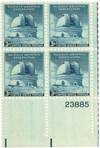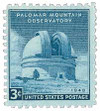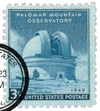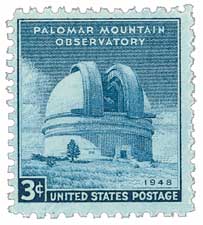
# 966 - 1948 3c Palomar Mountain Observatory
3¢ Palomar Mountain Observatory
City: Palomar Mountain, CA
Quantity: 61,120,010
Printed by: Bureau of Engraving and Printing
Printing Method: Rotary Press
Perforations: 10 1/2 x 11
Color: Blue
First Light Of The Hale Telescope
The Hale Telescope and Palomar Observatory were the brainchildren of US astronomer George Ellery Hale. He had previously overseen the building of 60-inch and 100-inch telescopes at the Mount Wilson Observatory in the early 1900s. These telescopes helped to vastly increase our understanding of the universe, and also demonstrated Hale’s argument that we needed even larger telescopes.
In 1928, Hale received a $6 million grant from the Rockefeller Foundation for a new observatory and 200-inch reflecting telescope. A few years later, Hale selected the site of the observatory, on Palomar Mountain, in San Diego, California. He believed it would be least affected by the increase in light pollution from large cities such as Los Angeles.

Construction on the dome began in 1936, however, the outbreak of World War II disrupted work on the 200-inch primary mirror for several years. Work on the telescope was finally completed in 1948. It saw first light on January 26, 1949. On that night at 10:06 pm, Edwin Hubble directed the telescope to NGC 2261, an object known as Hubble’s Variable Nebula. The photographs captured that night were then printed in Collier’s Magazine that May.
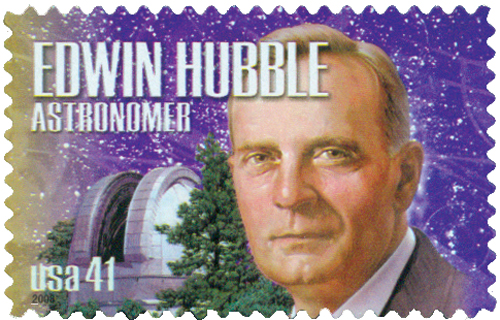
When the telescope first went into operation, there was some slight distortion in the images, so corrections were made throughout the year. Then in 1950, it was made available for research.
Quasars, extremely bright objects located at the center of other galaxies, were first detected using the Hale telescope in 1963. The energy from quasars takes billions of years to reach the Earth. Because of this, information about quasars helps scientists learn more about the nature of our universe.
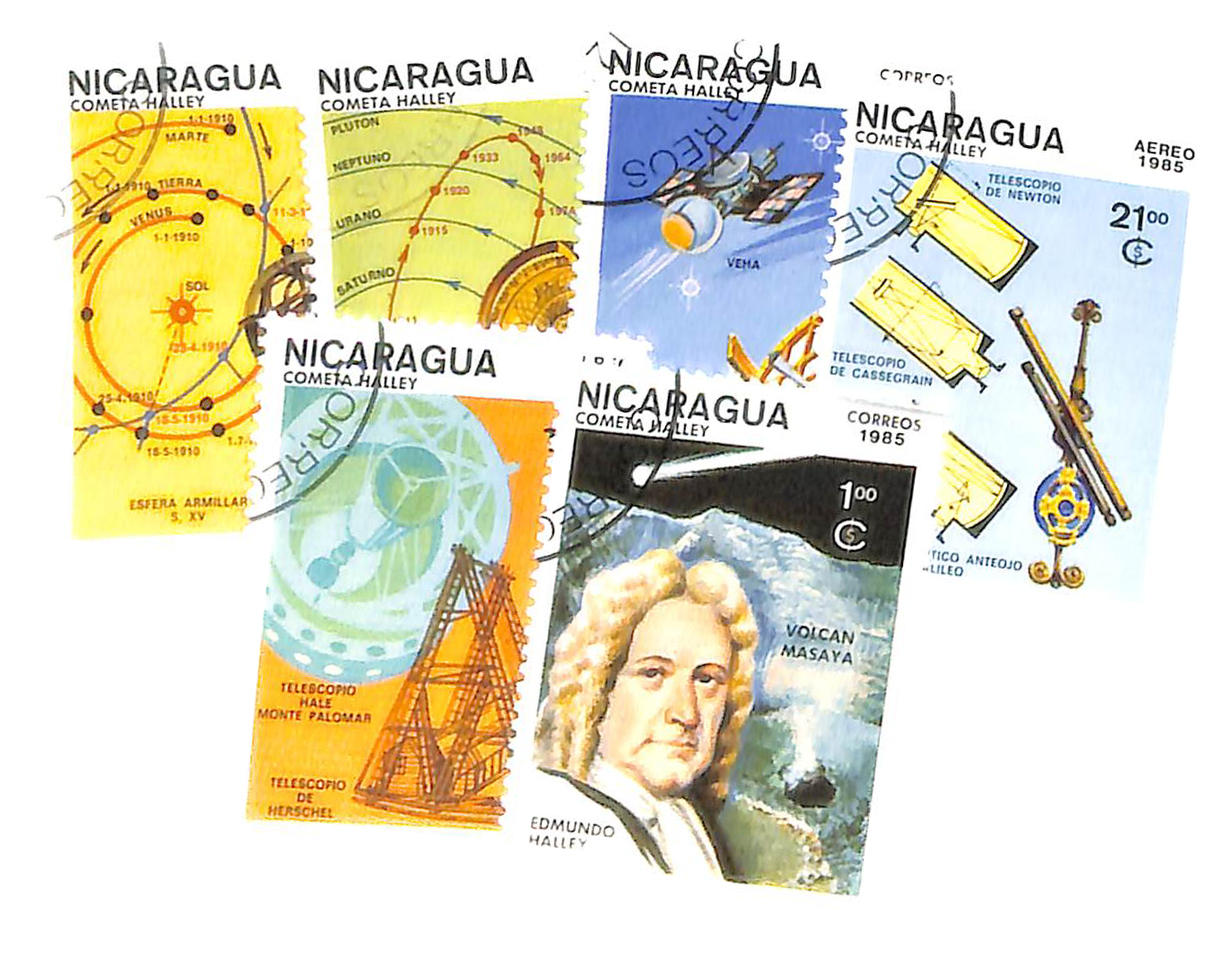
While using the Hale Telescope, Walter Baade was examining the Andromeda Galaxy, hoping to learn more about variable stars, those that expand and contract and change brightness in a predictable way. Though he was unsuccessful in his goal, he was able to take new measurements that showed the galaxy was twice as far away as astronomers had previously believed – this doubled the size of the known universe to astronomers.
Other astronomers using the telescope have studied the expansion of the universe and the chemistry of stars, finding that some undergo nuclear reactions at their cores.
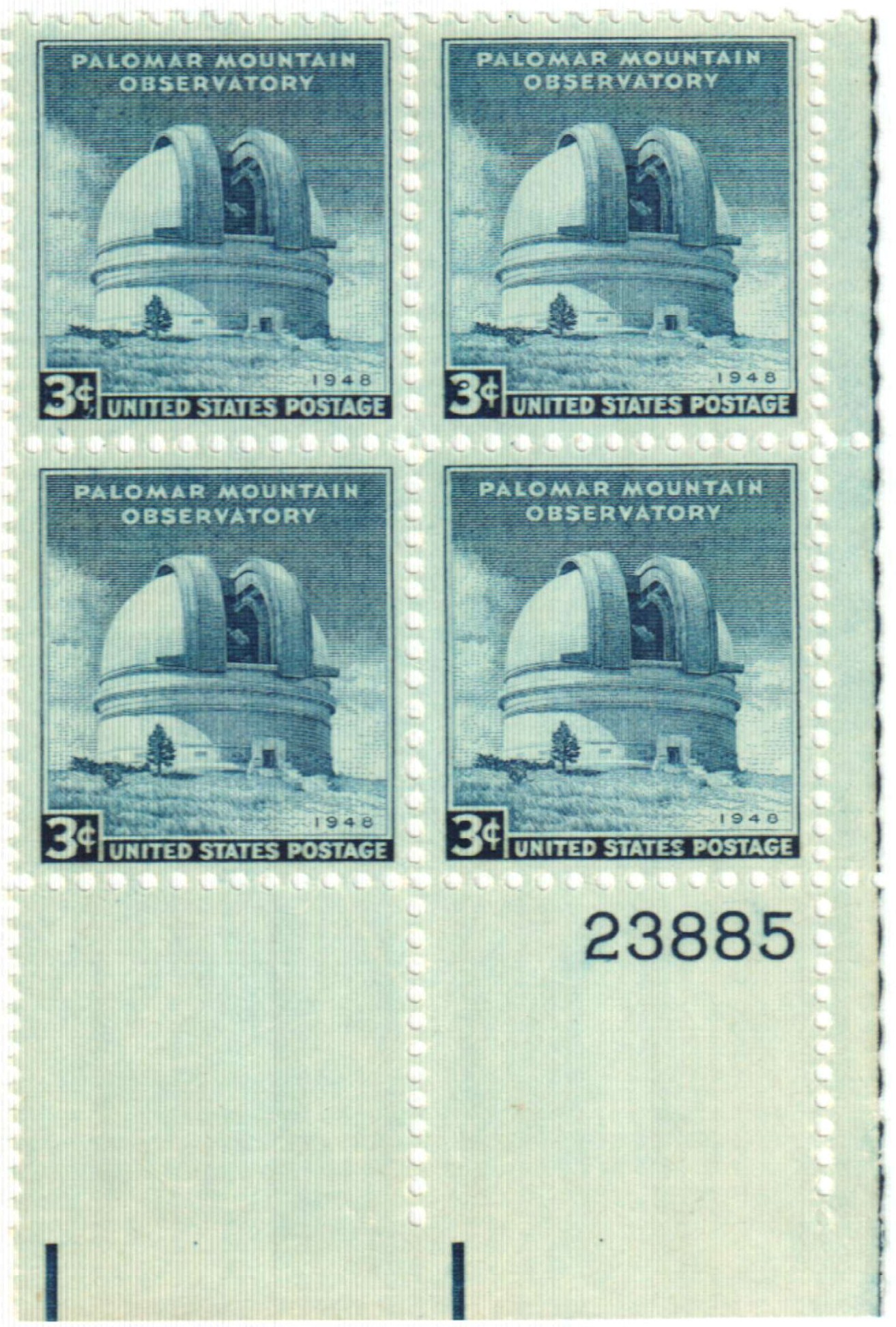
Still in use today, the Hale telescope is one of the world’s largest optical telescopes (meaning it collects and focuses visible light). Caltech, Cornell University, the University of California, and the Jet Propulsion Laboratory operate it. It has also been fitted with modern optical and infrared imagers as well as spectrographs and an adaptive optics system, which correct distortions caused by the Earth’s atmosphere.
The observatory also has several smaller telescopes. One of these, the 48-inch Ochin telescope, specializes in making wide-angle photographs. This has been useful in mapping the northern sky and creating a reference “sky atlas” for scientific use all over the world.
Click here for more about the Hale Telescope, including the first image it captured on this day in 1949.
3¢ Palomar Mountain Observatory
City: Palomar Mountain, CA
Quantity: 61,120,010
Printed by: Bureau of Engraving and Printing
Printing Method: Rotary Press
Perforations: 10 1/2 x 11
Color: Blue
First Light Of The Hale Telescope
The Hale Telescope and Palomar Observatory were the brainchildren of US astronomer George Ellery Hale. He had previously overseen the building of 60-inch and 100-inch telescopes at the Mount Wilson Observatory in the early 1900s. These telescopes helped to vastly increase our understanding of the universe, and also demonstrated Hale’s argument that we needed even larger telescopes.
In 1928, Hale received a $6 million grant from the Rockefeller Foundation for a new observatory and 200-inch reflecting telescope. A few years later, Hale selected the site of the observatory, on Palomar Mountain, in San Diego, California. He believed it would be least affected by the increase in light pollution from large cities such as Los Angeles.

Construction on the dome began in 1936, however, the outbreak of World War II disrupted work on the 200-inch primary mirror for several years. Work on the telescope was finally completed in 1948. It saw first light on January 26, 1949. On that night at 10:06 pm, Edwin Hubble directed the telescope to NGC 2261, an object known as Hubble’s Variable Nebula. The photographs captured that night were then printed in Collier’s Magazine that May.

When the telescope first went into operation, there was some slight distortion in the images, so corrections were made throughout the year. Then in 1950, it was made available for research.
Quasars, extremely bright objects located at the center of other galaxies, were first detected using the Hale telescope in 1963. The energy from quasars takes billions of years to reach the Earth. Because of this, information about quasars helps scientists learn more about the nature of our universe.

While using the Hale Telescope, Walter Baade was examining the Andromeda Galaxy, hoping to learn more about variable stars, those that expand and contract and change brightness in a predictable way. Though he was unsuccessful in his goal, he was able to take new measurements that showed the galaxy was twice as far away as astronomers had previously believed – this doubled the size of the known universe to astronomers.
Other astronomers using the telescope have studied the expansion of the universe and the chemistry of stars, finding that some undergo nuclear reactions at their cores.

Still in use today, the Hale telescope is one of the world’s largest optical telescopes (meaning it collects and focuses visible light). Caltech, Cornell University, the University of California, and the Jet Propulsion Laboratory operate it. It has also been fitted with modern optical and infrared imagers as well as spectrographs and an adaptive optics system, which correct distortions caused by the Earth’s atmosphere.
The observatory also has several smaller telescopes. One of these, the 48-inch Ochin telescope, specializes in making wide-angle photographs. This has been useful in mapping the northern sky and creating a reference “sky atlas” for scientific use all over the world.
Click here for more about the Hale Telescope, including the first image it captured on this day in 1949.




